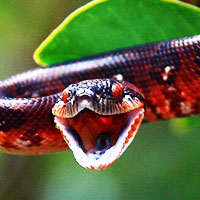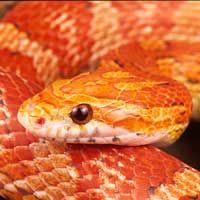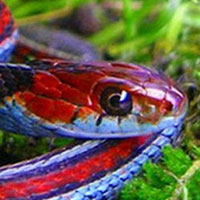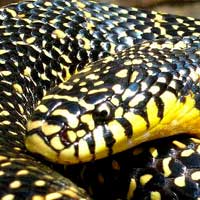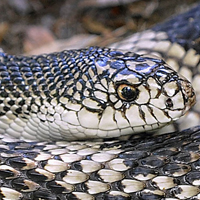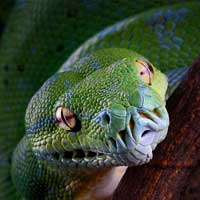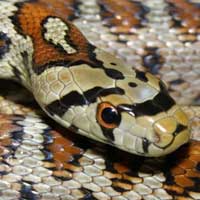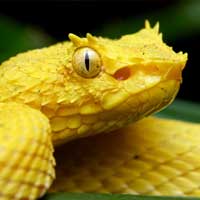All You Need to Know About the Stunning Emerald Tree Boa
The Emerald Tree Boa is scientifically named Corallus caninus. It belongs to the Boidae family, which includes non-venomous constrictor snakes.
Scientific Name: Corallus caninus
Snake Family: Boidae
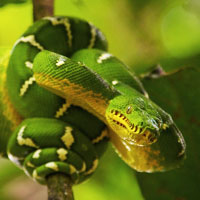
Emerald Tree Boa: A Vibrant Overview
The Emerald Tree Boa (Corallus caninus) is a strikingly beautiful snake native to the rainforests of South America. Known for its vibrant green color and white zigzagging patterns, this non-venomous boa is a favorite among reptile enthusiasts. Its arboreal nature and unique hunting techniques make it an intriguing species to observe. This guide covers everything you need to know about the Emerald Tree Boa, from its habitat and diet to care requirements and reproduction.
Unveiling the Natural Habitat of the Emerald Tree Boa
The Emerald Tree Boa thrives in the dense rainforests of the Amazon Basin, stretching across countries like Brazil, Venezuela, and Colombia. This arboreal snake spends most of its life in trees, using its prehensile tail to navigate branches.
| Habitat Feature | Description |
|---|---|
| Geography | Amazon Basin: Brazil, Venezuela, Colombia |
| Preferred Environment | Rainforests with high humidity and dense foliage |
| Activity | Primarily arboreal, seldom descends to the ground |
Emerald Tree Boa Diet: What Keeps Them Healthy?
The Emerald Tree Boa is a carnivorous snake that primarily preys on small mammals and birds in the wild. In captivity, their diet should mimic their natural feeding habits as closely as possible.
- Juveniles: Feed on small lizards or pinky mice every 5-7 days.
- Adults: Feed on appropriately sized rodents or birds every 10-14 days.
- Prey Size: Ensure prey is no larger than the snake's girth to prevent regurgitation.
- Always provide fresh water for hydration.
Behavior and Temperament of the Emerald Tree Boa
The Emerald Tree Boa is known for its unique resting posture, coiled around branches with its head in the center. Though stunning to observe, these boas can be defensive and require careful handling.
- Defensive Nature: These boas may strike if they feel threatened.
- Nocturnal Hunters: Active during the night, relying on heat-sensing pits to locate prey.
- Arboreal Lifestyle: Spend most of their time in trees and rarely come to the ground.
Caring for a Healthy Emerald Tree Boa
With proper care, the Emerald Tree Boa can live up to 15-20 years in captivity. Ensuring their enclosure mimics their natural habitat is crucial for their well-being.
| Health Concern | Symptoms | Prevention |
|---|---|---|
| Respiratory Infections | Wheezing, open-mouth breathing | Maintain proper temperature and humidity |
| Scale Rot | Discolored or damaged scales | Keep enclosure clean and dry |
| Stress | Refusal to eat, erratic behavior | Limit handling and provide ample hiding spots |
Reproduction in Emerald Tree Boas
Emerald Tree Boas are ovoviviparous, meaning they give birth to live young. Breeding these snakes in captivity can be challenging but rewarding for experienced keepers.
- Mating Season: Usually occurs during the rainy season.
- Gestation Period: 6-7 months.
- Litter Size: Typically 6-14 neonates.
- Provide a temperature gradient and maintain high humidity levels to encourage successful breeding.
Tips for Handling and Caring for an Emerald Tree Boa
Handling and caring for an Emerald Tree Boa requires patience and expertise. Their specific environmental needs make them best suited for advanced reptile keepers.
- Provide an enclosure with vertical space, such as a tall terrarium with branches.
- Maintain a temperature gradient of 80-90°F with a basking spot.
- Ensure humidity levels remain between 70-80%.
- Limit handling to avoid stress, as they can be defensive.
- Clean the enclosure regularly to prevent health issues.
